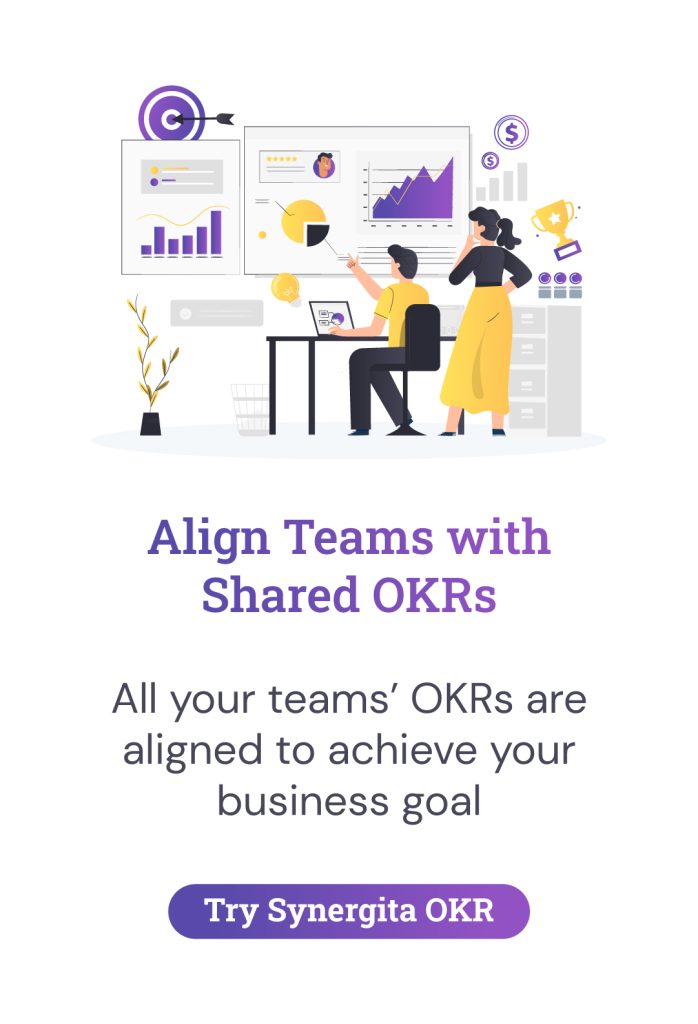In the ever-evolving realm of business strategy, success is no longer solely determined by the speed of innovation but by the precision with which organizations set, monitor, and achieve their goals. Enter Objectives and Key Results (OKRs), the navigational compass that has guided numerous industry giants towards their destinations of excellence. With the right OKR software, organizations can seamlessly track progress, align teams, and drive measurable outcomes. Imagine embarking on a voyage where your business objectives are distant horizons, and the key results are the strategic waypoints that guide your journey. The world full of implementing OKRs Successfully is akin to setting sail across the corporate seas, where each objective is a destination island, and each key result is a step closer to reaching those shores.
I. About OKRs:
Before implementing OKRs Successfully, it is very important to first orient ourselves to the heart of OKRs. Objectives and Key Results (OKRs) serve as the constellations that guide your organization’s trajectory. These are not mere goals; they are qualitative objectives intertwined with measurable key results, providing both direction and illumination for the journey ahead. This dynamic framework nurtures alignment, transparency, and collaboration, ensuring that your ship sails steadfastly toward shared aspirations.
II. Preparing for Implementation
A successful OKR implementation mirrors the preparation of a ship before it sets sail. This preparation involves laying a strong foundation that supports the voyage ahead. The first step is to anchor your OKRs to the bedrock of your company’s vision and mission. This alignment channels the energy of your organization toward a common purpose, propelling everyone forward with a sense of unity. Crafting objectives that strike a balance between clarity and ambition is the next essential task. Clear objectives are the guiding stars, while ambitious ones propel your teams to reach for greatness, fostering a culture of aspiration and achievement. And let us not forget the sails of cross-team collaboration—this wind ensures that your goals are embraced by all aboard, igniting the collective power of diverse minds.
| Key Principles | Detail |
| Aligning with Vision | Infuse your OKRs with the essence of your company’s vision and mission, ensuring every action is directed toward a unified purpose. This connection fosters a shared commitment to success. |
| Crafting Clear Objectives | Develop objectives that are crystal clear, driving everyone forward with unwavering focus. This clarity eliminates confusion and aligns efforts. |
| Embracing Collaboration | Promote cross-team collaboration as the compass that guides collective efforts, fostering diverse perspectives and innovative solutions. This synergy capitalizes on the strength of teamwork. |
III. Step-by-Step Guide for Implementing OKRs Successfully
- Setting Sail with Alignment: Begin your journey by anchoring your OKRs to your organization’s overarching vision. This alignment acts as a magnetic force that unifies and propels everyone forward, creating a shared sense of purpose that transcends individual tasks.
- Charting the Course with Ambitious Objectives: Think of your objectives as the Northern Star—a constant reference point. Keep them precise and inspiring, offering a challenge that fuels motivation and sparks determination. Ambitious objectives encourage teams to push their limits and achieve greatness.
- Cross-Team Collaboration Voyage: Encourage diverse teams to unite and collaborate, capitalizing on the power of collective intelligence. This synergy creates an ecosystem where fresh ideas flow freely, sparking innovative solutions that might not emerge in isolated silos.
- Navigating Quarterly Reviews: Just as sailors use navigational tools to course-correct, regular reviews of your OKRs allow you to adjust your sails. These reviews provide the opportunity to gauge progress, celebrate successes, and recalibrate efforts if needed, ensuring your journey remains on track.
- Fostering Agile Adaptation: Embrace the agile principles of flexibility and adaptation. Just as Netflix pivots its content based on user preferences, be open to adjusting your OKRs in response to changing market dynamics, emerging opportunities, and unforeseen challenges.
- Embodying a Growth Mindset: Inspire a growth mindset, drawing inspiration from Google’s emphasis on learning and development. Encourage your teams to view setbacks as learning experiences and use failures as stepping stones toward improvement and innovation.
- Leveraging Technology Tools: Leverage technology tools and software platforms to streamline the OKR process, mirroring Amazon’s use of technology to optimize its operations. These tools can simplify tracking, reporting, and communication, enhancing transparency and accountability.
IV. Overcoming Implementation Challenges
While implementing OKRs successfully, challenges can disrupt your journey. Resistance to change and misalignment might appear as obstacles. However, these challenges can be opportunities in disguise.
- Embrace Uncertainty: See challenges as chances for growth, sparking innovation, and unexpected benefits.
- Navigate Resistance: Emphasize OKRs’ long-term benefits to overcome resistance and foster collaboration.
- Align Perspectives: Open dialogue and shared understanding mitigate misalignment, promoting smoother implementation.
- Encourage Open Communication: Create an environment where concerns are voiced, enabling proactive problem-solving.
- Adapt to Change: Flexibility is vital in adjusting OKRs to changing circumstances for continued relevance.
- Leverage Setbacks: Treat setbacks as springboards for learning and innovation, enhancing strategies.
- Cultivate Learning Culture: Prioritize continuous learning to enhance adaptability and resilience.
- Celebrate Progress: Recognize small victories to boost morale and highlight OKRs’ impact.
By adopting these approaches, challenges can be transformed into catalysts for advancement in your OKR journey.
V. Best Practices for Smooth Implementation
A treasure trove of best practices awaits those seeking a seamless OKR journey. Draw inspiration from the strategies of industry leaders like Netflix, Amazon, and Google:
- Transparency: Share your OKRs openly throughout the organization, cultivating a culture of accountability and alignment. Like Netflix’s transparent communication, this practice ensures everyone is on the same page and committed to shared goals.
- Ongoing Support: Equip teams with the tools and resources they need. Just as Google supports its employees, providing guidance and assistance fosters an environment where goals can be achieved effectively. This support also emphasizes that success is a collective effort.
- Celebration and Motivation: Celebrate not only major milestones but also minor victories along the journey. Echoing Netflix’s recognition practices, these celebrations infuse positivity and maintain high levels of motivation, keeping everyone engaged and focused.
- Learning from Setbacks: Embrace setbacks as steppingstones for growth. Just as Amazon leverages failures for innovation, view challenges as opportunities to learn, adapt, and come back stronger. This approach encourages a resilient and forward-thinking mindset.
- Fostering Cross-Functional Collaboration: Encourage collaboration across teams and departments. Much like Amazon’s diverse and collaborative teams, cross-functional cooperation promotes the exchange of ideas, fuels innovation, and helps achieve challenging goals.
- Regularly Reassess and Adapt: Regularly review and reassess your OKRs. Like Google’s commitment to staying relevant, this practice ensures that your objectives remain aligned with changing business dynamics and evolving priorities.
Incorporating these best practices into implementing OKRs successfully strategy can significantly enhance your chances of success. By combining insights from these industry giants, you’re equipping your organization with a powerful toolkit for a smooth OKR journey.
VII. Nurturing a Long-Term OKR Culture
Your OKR journey is more than a one-time endeavor – it’s a transformative experience that can reshape your organization. To ensure sustained success, cultivate an OKR culture that stands the test of time. Take cues from successful strategies and foster a culture that champions OKRs for the long haul:
- Embrace Continuous Learning: Encourage perpetual learning. Inspire teams to stay curious, explore new methods, and adapt to change. A culture of ongoing learning ensures adaptability and agility.
- Foster Adaptability: Embrace change as a constant. Promote a culture that responds to shifting landscapes with resilience and resourcefulness. Adaptability equips your organization to navigate challenges.
- Promote Innovation: Cultivate an environment that values innovative thinking. Empower teams to experiment, take calculated risks, and discover creative solutions to achieve objectives.
- Empower Ownership: Grant teams ownership of their OKRs. Fostering a sense of accountability and commitment to results drives progress. Ownership unites teams toward collective success.
- Encourage Feedback: Create a feedback-rich atmosphere. Regular input from teams and individuals fuels improvement and refines strategies, driving overall success.
- Lead by Example: Set the tone from the top. Leadership commitment to OKRs encourages transparency, trust, and enthusiastic participation throughout the organization.
- Celebrate Progress and Learning: Acknowledge milestones and growth. Celebrating both accomplishments and lessons learned maintains motivation and reinforces the journey’s value.
- Reinforce Core Values: Align OKRs with your organization’s core values. This alignment ensures a sense of purpose and direction in your OKR journey.
By instilling these principles into your organization’s fabric, you’re fostering an enduring OKR culture that will not only illuminate your path to success but also shape your organization’s journey for years to come.
VIII. Conclusion
As we conclude our journey, keep in mind that OKRs are more than a strategy—they embody a mindset that propels excellence.
In the words of the renowned management guru Peter Drucker, “What gets measured gets improved.” With alignment, collaboration, adaptation, and celebration as your compass, you’re on the path to elevating your organization’s performance.
Transparent communication, unwavering support, and a commitment to learning will guide you through obstacles toward sustained success.
With implementing OKRs successfully as your guiding light, your journey toward organizational excellence continues. So, set sail with OKRs, navigate the currents of strategic implementation, and let the winds of ambition drive you to remarkable achievements. Your OKR adventure has just begun!
FAQs
1. How can OKRs benefit my organization’s growth?
OKRs provide a strategic framework that aligns teams and individuals with overarching goals. This alignment enhances focus, collaboration, and adaptability, driving growth and improved performance.
2. Are OKRs suitable for organizations of all sizes?
Yes, OKRs can be tailored to fit organizations of varying sizes. From startups to large enterprises, the OKR methodology can be adapted to suit different needs and scales.
3. What is the recommended frequency for setting OKRs?
Many organizations set OKRs on a quarterly basis. This timeframe allows for short-term focus while enabling adaptability to changing market conditions and organizational priorities.
4. How can cross-functional collaboration be fostered through OKRs?
OKRs encourage cross-functional collaboration by aligning teams toward common objectives. When teams collaborate across departments, diverse perspectives lead to innovative solutions and enhanced outcomes.
5. How do OKRs contribute to employee engagement and motivation?
OKRs provide a sense of purpose and clarity. When employees understand their roles in achieving overarching goals, their engagement and motivation increase, leading to higher job satisfaction and performance.
6. What if our organization faces challenges in achieving OKRs?
Challenges are a natural part of any journey. OKRs promote transparency, allowing for early identification of challenges. This transparency facilitates proactive problem-solving and strategic adjustments.
7. Can OKRs be used in combination with other management frameworks?
Yes, OKRs can complement other management frameworks such as Agile or Lean. The adaptability of OKRs allows them to integrate seamlessly with existing methodologies for enhanced organizational performance.
8. How do OKRs contribute to organizational alignment?
OKRs cascade objectives from top to bottom, ensuring alignment at all levels. This alignment creates a cohesive direction, enabling each team to contribute meaningfully to the organization’s success.
9. What are some common pitfalls to avoid in OKR implementation?
Avoid setting too many objectives or key results, neglecting regular progress tracking, and lacking clear alignment. Additionally, ensure that OKRs remain adaptable and focused on results.
10. How can a long-term OKR culture be nurtured within an organization?
Nurturing a long-term OKR culture involves fostering continuous learning, adaptability, innovation, and ownership. By aligning with core values and celebrating both progress and learning, a sustainable OKR culture can thrive.
Related articles:

